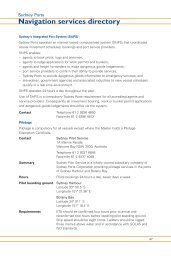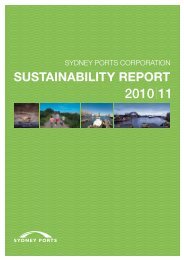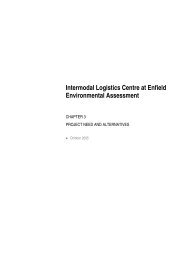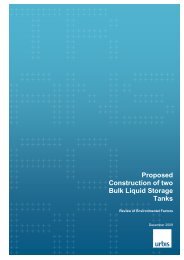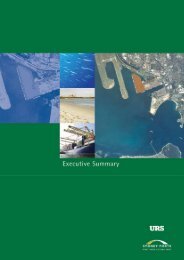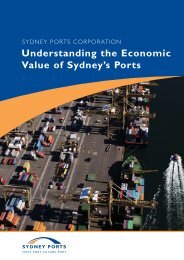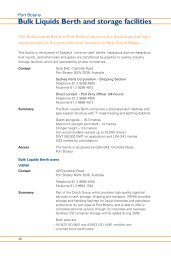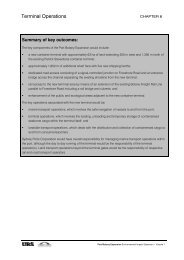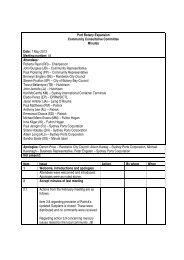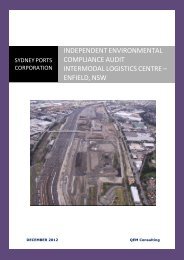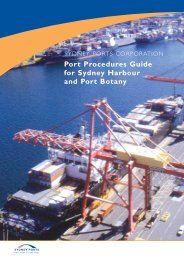SYDNEY PORTS CORPORATION ANNUAL REPORT 12
SYDNEY PORTS CORPORATION ANNUAL REPORT 12
SYDNEY PORTS CORPORATION ANNUAL REPORT 12
Create successful ePaper yourself
Turn your PDF publications into a flip-book with our unique Google optimized e-Paper software.
78<br />
Sydney PortS CorPoration<br />
noteS to the FinanCiaL StateMentS<br />
note 16. finanCial riSk management oBJeCtiveS and PoliCieS (ContinUed)<br />
(c) Credit risk<br />
Credit risk arises when there is the possibility of the Corporation’s debtors defaulting on their contractual obligations,<br />
resulting in a financial loss to the Corporation. The maximum exposure to credit risk is generally represented by the<br />
carrying amount of the financial assets (net of any allowance for impairment).<br />
Credit risk arises from the financial assets of the Corporation, which comprise cash and cash equivalents and trade and<br />
other receivables. The Corporation has not granted any financial guarantees.<br />
Credit risk associated with the Corporation’s financial assets, other than trade and other receivables, is managed through<br />
the selection of creditworthy counterparties and recognised financial intermediaries as a means of mitigating against the<br />
risk of financial losses from defaults. In addition, only highly liquid marketable securities are used for investment purposes.<br />
The Corporation trades only with recognised creditworthy third parties. Trade customers who wish to transact on credit<br />
terms are subject to credit verification procedures which may result in obtaining bank guarantees. In addition, receivable<br />
balances are monitored on an ongoing basis to minimise the exposure to bad debts.<br />
The Corporation is not materially exposed to a concentration of credit risk to a single trade debtor. The largest single trade<br />
debtor included in receivables totals $1.180 million (2011: $1.177 million) and is 0.87% of total financial assets (2011: 0.66%).<br />
(d) Liquidity risk<br />
Liquidity risk is the risk that the Corporation will be unable to meet its payment obligations when they fall due. The<br />
Corporation continuously manages liquidity risk through monitoring future cash flows and maturities planning to ensure<br />
an adequate holding of high quality liquid assets. The aim of liquidity risk management is to ensure that the Corporation<br />
has sufficient funds available to meet its obligations both on a day to day basis and in the longer term. That is, its aim is to<br />
ensure that new funding and refinancing can be obtained when required and without undue concentration at times when<br />
financial markets might be strained. Provided that these aims are met, the policy also aims to minimise net finance costs.<br />
During the current and prior years, there were no defaults or breaches on any loans payable. No assets have been pledged<br />
as collateral. The Corporation’s exposure to liquidity risk is deemed insignificant based on prior periods’ data and a current<br />
assessment of risk.<br />
Liabilities are recognised for amounts due to be paid in the future for goods or services received, whether or not invoiced at<br />
reporting date. Amounts owing to suppliers (which are unsecured) are settled in accordance with trade terms. If trade<br />
terms are not specified, payment is made within 28 days of recognition.<br />
The following table summarises the maturity profile of the Corporation’s financial liabilities, together with the interest rate exposure.<br />
The maturity profile is based on the remaining contractual maturity period at the reporting date. The nominal amounts are<br />
the contractual undiscounted cash flows (including both interest and principal cash flows) of each class of financial<br />
liabilities and therefore will not reconcile to the statement of financial position.<br />
weighted<br />
average<br />
effeCtive<br />
intereSt<br />
rate<br />
Carrying<br />
valUe<br />
$000<br />
Sydney PortS CorPoration finanCial rePort 2011/<strong>12</strong><br />
intereSt rate eXPoSUre ContraCtUal matUrity dateS<br />
nominal<br />
amoUnt<br />
$000<br />
fiXed<br />
intereSt<br />
rate<br />
$000<br />
variaBle<br />
intereSt<br />
rate<br />
$000<br />
nonintereSt<br />
Bearing<br />
$000<br />
< 1 year<br />
$000<br />
1–5 yearS<br />
$000<br />
> 5 yearS<br />
$000<br />
At 30 June 20<strong>12</strong><br />
Financial liabilities<br />
Trade and other<br />
payables<br />
Lease incentive<br />
N/A 62,176 62,176 – – 62,176 62,176 – –<br />
liability<br />
Interest-bearing loans<br />
N/A 3,874 4,682 – – 4,682 1,079 1,998 1,605<br />
and borrowings 6.36% 604,574 916,667 916,667 – – 43,063 432,213 441,391<br />
At 30 June 2011<br />
Financial liabilities<br />
Trade and other<br />
670,624 983,525 916,667 – 66,858 106,318 434,211 442,996<br />
payables<br />
Lease incentive<br />
N/A 51,839 51,839 – – 51,839 51,839 – –<br />
liability<br />
Interest-bearing<br />
loans and<br />
N/A 4,145 6,207 – – 6,207 2,334 1,624 2,249<br />
borrowings 6.36% 603,826 943,826 943,826 – – 35,111 207,316 701,399<br />
659,810 1,001,872 943,826 – 58,046 89,284 208,940 703,648



